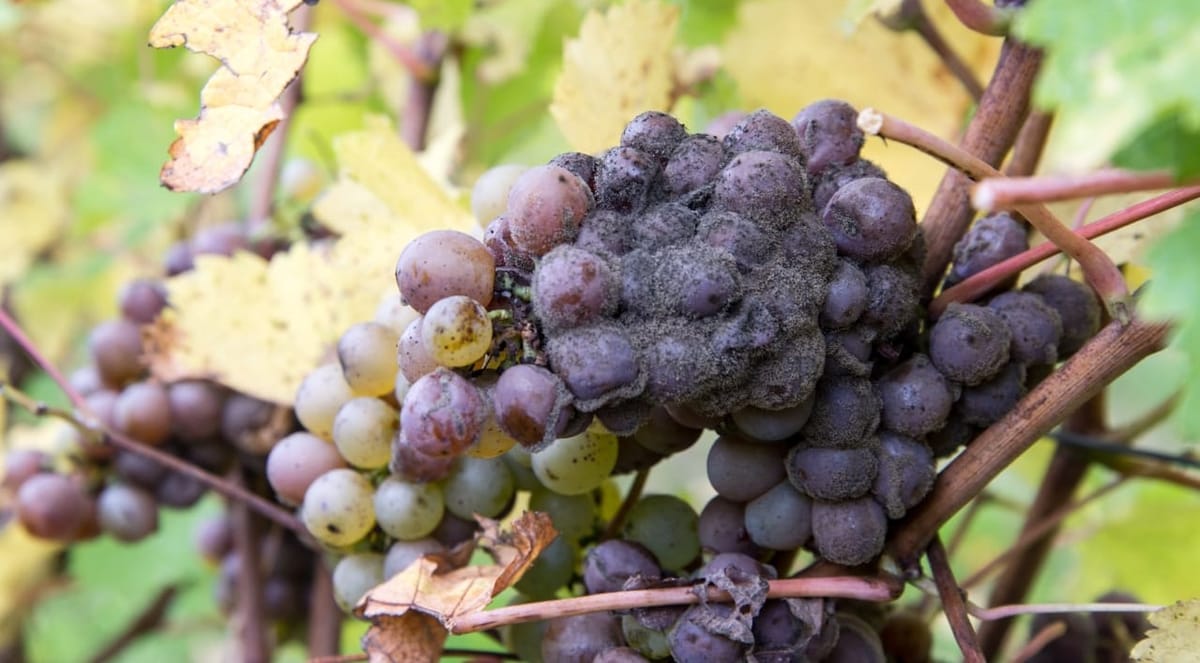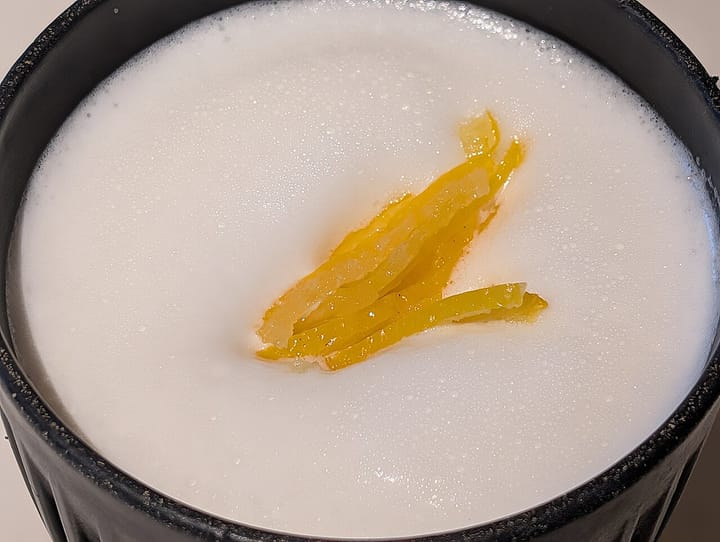Noble Rot: When Rotting Grapes Are Celebrated
Botrytis cinerea, known as "noble rot," is a fungus that invades grapes, causing the water inside to evaporate through the fruit's skin. With the perfect balance of humidity and warmth, Botrytis can turn these grapes into what are often described as "golden liquid."

Under ideal conditions of suitable humidity and warmth, Botrytis cinerea, also known as noble rot, transforms grapes into what are often called "golden treasures."
This fungus highly concentrates the sugar and juice within the grapes, achieving levels well beyond typical ripeness, with potential alcohol ranging from 18-30°, equivalent to averagely 500 grams of sugar per liter.
Known by various names—pourriture noble in French, Edelfäule in German, muffa nobile in Italian, and aszúsodás in Hungarian—noble rot bestows a unique quality on wines.
What is Noble Rot?
Noble rot, also known as Botrytis cinerea, is a fungal condition that, surprisingly, is welcomed by many winemakers.
This fungus, belonging to the Ascomycota division in the kingdom of Fungi, is responsible for the unique character of certain wines.
Similar to other ascomycetes, which include the antibiotic-producing penicillin and the mold found in Stilton blue cheese, Botrytis cinerea affects more than just grapes—it can be found on a variety of fruits, vegetables, and flowers, like a moldy strawberry.
So, Why Do Winemakers Hope for Grapes Affected by Noble Rot?
Noble Rot,' scientifically known as Botrytis cinerea, is pivotal in creating some of the most esteemed sweet wines globally, including Bordeaux's Sauternes, Hungary's Tokaji Aszu, and Spätlese Rieslings from Germany.
This fungus induces a paradoxical decay in grapes, causing them to shrivel while simultaneously concentrating their sugars and flavors.
This process not only enhances the sweetness of the wine but also contributes to its complex and unique flavor profile, making these wines highly prized for their distinctive characteristics.
The mechanism by which 'Noble Rot' enhances wine is two-fold. Firstly, it causes the grapes to dehydrate, maintaining high sugar concentrations even as the fruit loses moisture.
As a result, a larger quantity of grapes is required to produce the same volume of juice, which in turn is richer in sugar, leading to more viscous and intensely sweet dessert wines.
Some of these wines may also exhibit higher alcohol levels due to the increased sugar content available for fermentation.
Secondly, 'Noble Rot' adds a layer of complexity to the wine's flavor. It is often credited with introducing aromas of honey, beeswax, and ginger.
These notes are partly due to the presence of phenylacetaldehyde, an aromatic compound also found in buckwheat and milk chocolate, which Botrytis-infected wines tend to have in higher concentrations.
This compound enriches the wine, adding depth and richness that enhance its overall sensory profile.
The Discovery of Noble Rot
The intentional use of Botrytis cinerea to produce wine is thought to have originated by accident. According to legend, in the late 18th century, the harvest at the Tokaji vineyards in Hungary was delayed due to unexpected weather.
This delay allowed Botrytis cinerea to develop on the grapes. The resulting wine was found to be superior to typical harvests, leading to the intentional introduction of the fungus in later vintages.
Similarly, in the Bordeaux region of France, the Sauternes district became renowned for its botrytized wines.
Chateau d'Yquem, a leader in Sauternes wine, has records dating back to 1711, indicating a well-established appreciation for the unique qualities imparted by noble rot.
Scientific Insight and Modern Techniques
The scientific community began to take an interest in Botrytis cinerea in the 19th century.
Louis Pasteur's research into fermentation provided insights into how and why certain molds could enhance the wine-making process rather than detract from it.
This scientific backing helped vintners better understand how to control the conditions that encouraged the development of noble rot, leading to more consistent and high-quality production.
In modern vineyards, the cultivation of botrytized wine is a careful balance of art and science.
Vintners must monitor humidity and temperature closely to ensure that the rot develops favorably and does not progress into less desirable forms of decay.
The timing of the harvest is critical; grapes must be picked at just the right point of infection for optimal sugar concentration and acidity.
Flavor Profile of Noble Rot Wines
Noble Rot wines are celebrated for their rich complexity and unique profiles. Here’s a guide to the distinctive aromas and flavors that make these wines a gourmet’s delight:
1. Honey
Perhaps the most prominent and beloved note in Noble Rot wines is honey. This sweet and alluring aroma is a direct result of the high sugar concentration in the botrytized grapes, giving the wine a warm, rich quality.
2. Apricot and Dried Fruits
Noble Rot often brings out intense fruit flavors, with apricot being particularly noticeable. Alongside, you might detect nuances of dried fruits like raisins and figs, adding depth and a lush fruitiness to the palate.
3. Citrus and Marmalade
These wines can also exhibit bright citrus notes, ranging from fresh lemon zest to the sweet and tangy complexity of orange marmalade. This citrus character adds a refreshing contrast to the sweetness.
4. Spices
Spicy undertones such as ginger, saffron, and nutmeg are common in these wines. These spices provide a warming effect and complexity that can elevate the tasting experience, adding layers that unfold with each sip.
5. Botanicals
Subtle hints of botanicals like tea, herbs, and even a touch of earthiness can be present. These flavors often mingle with the primary fruit and honey notes, creating a sophisticated bouquet.
6. Beeswax
The texture and smell of beeswax are often noted in Noble Rot wines, contributing to the rich, smooth mouthfeel and adding a subtle complexity to the flavor profile.
7. Almond and Marzipan
In some Noble Rot wines, especially those aged for a longer period, you might pick up hints of almond and marzipan. These flavors contribute to the overall nuttiness and add a creamy, rich texture.
8. Caramel and Toasted Sugar
The process of concentration and aging may impart notes of caramel or toasted sugar, enhancing the wine’s richness and adding a decadent, dessert-like quality.
The Process of Making The Botrytis Wine
The process of making noble rot wine, also known as "Botrytized" wine, is a fascinating and meticulous journey from vine to barrel. Here's an in-depth look at each step:
1. Grape Development and Botrytis Infection
Noble rot wine starts with the development of the grapes, specifically varieties like Sémillon, Sauvignon blanc, and Muscadelle. These grapes are grown in specific regions where the conditions are ripe for the development of Botrytis cinerea, a fungus that is essential to this wine. The ideal conditions include misty or damp mornings followed by dry, sunny afternoons which encourage the growth of the fungus without rotting the fruit.
2. The Onset of Noble Rot
Botrytis cinerea, when it infects the grapes under the right conditions, causes them to lose moisture while maintaining high sugar levels. This process, known as "noble rot," concentrates the sugars and acids in the grapes, and it also alters their flavor profile, adding unique complexities.
3. Harvesting
Harvesting grapes for noble rot wine is labor-intensive and precise. Workers often pass through the vineyard several times, picking only the grapes that are sufficiently affected by the rot. This selective harvesting ensures that only the best grapes go into the wine, and it might take several weeks to complete.
4. Pressing and Fermentation
Once harvested, the grapes are gently pressed to extract the highly concentrated juice. The sugar levels in this juice are so high that yeast struggles to ferment it, leading to a longer and slower fermentation process. This slow fermentation is crucial for developing the wine's distinctive flavors.
5. Aging
After fermentation, the wine is typically aged in oak barrels. The aging process can last several months to several years depending on the desired outcome. During this time, the wine develops complexity and the flavors imparted by the noble rot are melded and enhanced by the characteristics of the oak.
6. Bottling
Once aging is complete, the wine is carefully bottled to preserve its unique and delicate flavors. Bottling is often done under inert gas to prevent oxidation and preserve quality.
Final Thoughts
Noble rot wines, such as the famous Sauternes from Bordeaux, are prized for their complexity and balance of sweetness and acidity.
The entire process, from the development of the grapes to the careful aging in barrels, requires precision and patience, contributing to the rarity and cost of these wines.
This labor-intensive process, along with the unique flavor profiles created by Botrytis cinerea, explains why noble rot wines are both expensive and highly sought after by connoisseurs.


